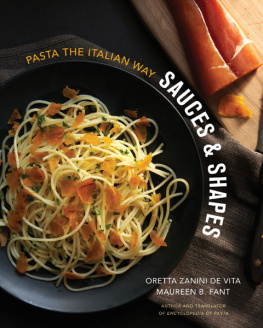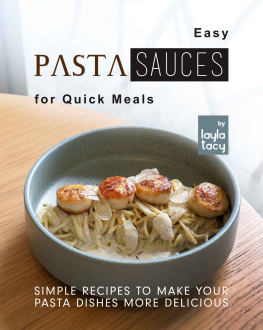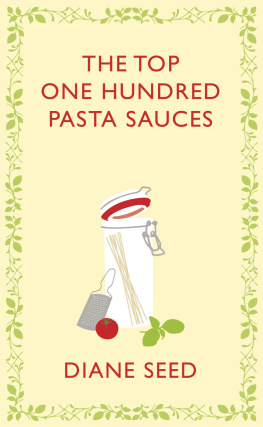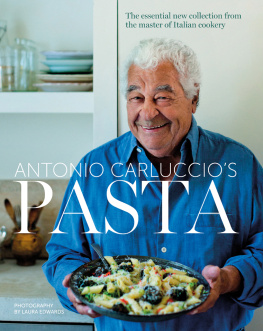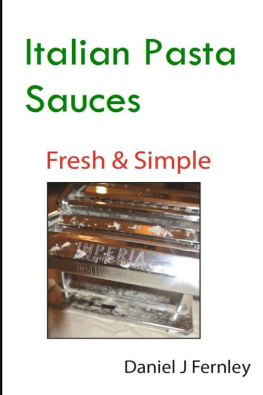N OBODY MAKES a journey through the world of Italian pasta without plenty of company. Even if there were no one else, wed have had the generations of resourceful, creative Italians, mostly women, who first formed lumps of dough into strings, balls, hats, spindles, lozenges, disks, and variously shaped and decorated dumplings and gave them witty names. But we have more than ghosts to thank.
If youve reached this page, you already have an idea of our debt to the photographers Andrea Gentl and Marty Hyers and to Michael Pedersen, food stylist, and his assistant Tracy Keshani, a crack team that turned our modest dishes into works of artand did it in record time with patience, care, intelligence, and simpatia. Luciana Marini, in Rome, has our gratitude for her beautiful and accurate drawings and for her friendship and the chickpeas from her garden.
Numerous expert friends generously and enthusiastically provided useful information, material assistance, and wise advice, editorial and otherwise, from the most varied points of view (and answered cries for help with alacrity). In the United States they include Nick Anderer, Charlotte Cox, Fanny Farkas, Susan Friedland, and Arthur Schwartz, always there when needed. Then there were the specialists. Jim Zurer could always come up with a relevant Web link with the speed of light. Craig (Meathead) Goldwyn knows, and tells, everything about pork. Nancy Harmon Jenkins and Sara Jenkins consulted on lobster from Maine. Michael Putnam approved our remarks about Horace. Lisa Sasson assured us that pasta deserves a place in a balanced diet. Hank Shaw, forager, was our rabbit and hare man. Michelle Farkas was our Stateside Italian-wine consultant and is responsible for most of the pairings we suggest in this book (but if anyone disagrees with them, dont blame Michelle!).
Fanny Farkas, Michelles mother, stepped up and started cooking our recipes in New York, which sometimes involved leaving the comfort of her Upper East Side kitchen to seek exotic seafood in Chinatown. Her perspective and skill were crucial to making many of the recipes suitable for North American kitchens, and her friendship and solidarity crucial, period.
Chris Tucker provided venison advice from Australia. From France came the counsel of a great editor and a great wine writer, Robert Marino and Jacqueline Friedrich.
We also thank Leeann Graham and Marc Kagan for their very helpful suggestions, as well as Judith and David Barrett for their wisdom and encouragement.
In Italy, our friend Amalia Palleschi was always available (often to help Oretta with English). Gaetano Basile, in Palermo, provided authoritative notes on Sicilian cooking. Mario Mozzetti, of the restaurant Alfredo alla Scrofa, graciously provided the original Alfredo recipe. Naina Vohra appeared like magic in Rome in an early stage of the work to knead and measure until the wind changed. Leda Tripodi took such an interest in the project that she dragged her friend Maria Antonietta Castiello over to my house to show me how the women of Basilicata roll the most delicate fusilli on a piece of straw. Leda also had a friends father in Campania make a ferretto for me, making me perhaps the only home cook in Rome (I would guess) to own a ferretto she did not inherit from a southern mother or grandmother. (Orettas ferretto belonged to her mother-in-law.) Mina Botti shared her skill with the ferretto and dough in general.
Iris Carulli, another Manhattanite transplanted to Rome and most precious friend, provided invaluable culinary, editorial, and moral support, as well as that essential experience of two worlds that we share. She is also responsible for most of the Web-shopping guide, with contributions from Jim and Fanny.
But a book is more than words on a page. I owe a debt to the wonderful vendors in the Testaccio quarter of Rome, who have been patiently sharing their experience with me for more than thirty years. Oretta particularly thanks Aldo Palmieri, who cares for her Sabine garden, often invoked in these pages, Renato Adamo, whose great olive oils underlie many of these recipes, and her brilliant butcher, Marco Coppotelliand as a frequent beneficiary of all, so do I. Francesco Filippi, Franco, my husband, tasted several pastas a week for about a year and a half (somebodys got to do these tough jobs), hosted multipasta dinner parties, and patiently watched me spend all my time between meals writing or talking on the phone to Oretta. He has been an intelligent, enthusiastic, and much-loved guinea pig and companion throughout.
Our wonderful agent, Jennifer Griffin, has provided good advice all along the way, and the best advice of all was to work with Maria Guarnaschelli, a great editor, inspiring to her authors and unsparing also of herself to make a better book. We are extremely proud to be published by Norton and are obliged there also to Julia Druskin, Ingsu Liu, Nancy Palmquist, and Susan Sanfrey, as well as to Melanie Tortoroli, Will Glovinsky, and Mitchell Kohles, Marias former and current assistants. Laura Starretts careful proofreading will surely have saved many a dinner.
Grateful thanks to all, while blame for any failings must be ours.
Most of all, Oretta and I thank each other. I am honored to be her voice in English, and she has been my generous friend, teacher, and counselor over these decades of learning to know and love Italy through its food.
BY ORETTA ZANINI DE VITA, TRANSLATED BY MAUREEN B. FANT
Encyclopedia of Pasta
Popes, Peasants, and Shepherds: Recipes and Lore from Rome and Lazio

T HE RECIPES ARE drawn from the home-cooking traditions of all parts of Italy, and some are common throughout the country. In not dividing the recipes by region or (more realistically) locality, we aim to emphasize characteristics of Italian home cooking.
Judicious suggestions for substitutions are made, but overall the recipes are quite faithful to their roots. And therein lies a challenge to you, dear reader. If you observe a few basic precepts, the recipes will reward you with dishes you might (almost) find in Italian homes and trattorias. But if you start second-guessing and adding more ingredients or substituting cheap oil for good, oil for pork fat (except where authorized), dried herbs for fresh, all bets are off. Here are the ground rules:
Use the best ingredients you can find in every category.
Skip an ingredient sooner than use a poor imitation.
Look at the pot, not the clock.
Dont obsess over measurements of ingredients and sizes of cookware.
Do obsess over quality of ingredients.
The main difference between Italian cooking in Italy and elsewhere is the number of ingredients. Thats worth repeating. Outside Italy, cooks like to keep adding things, such as ever more garlic, or garlic where theres already an onion doing a fine job on its own, or hot pepper or cheese that will overpower delicate flavors. Italian palates are used to picking up subtleties and do not appreciate these brash jumbles of aggressive flavors.
Most of these recipes depend on the excellence of the main ingredient. Or rather the second ingredient, because the main ingredient is the pasta. All the sauces and soups in this book, and in Italian cooking in general, depend on the quality of their ingredients. Nowadays a decently stocked Italian pantry is within reach of anyone willing to do a little Web surfing. If imported canned tomatoes, dried pasta, anchovies, capers, olives, and extra virgin olive oil are not available at your local store, there is always the Internet. A shopping guide is provided on .
From this point of view, the pasta recipes are probably the easiest part. Much Italian pasta is already made from North American flour, and fresh eggs arent hard to come by (but, please, from happy chickens). Perfect fresh pasta takes technique and practice, but, yes, you can learn outside Italian borders, nor will we ever berate you for seeking help from a machine.
Next page
